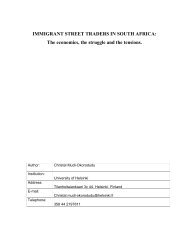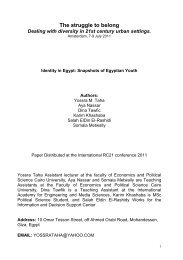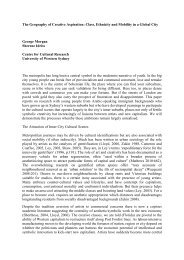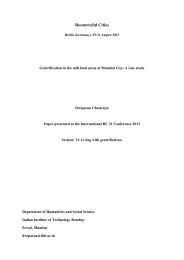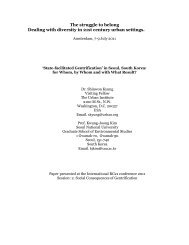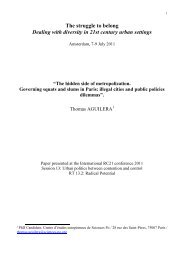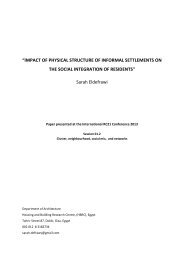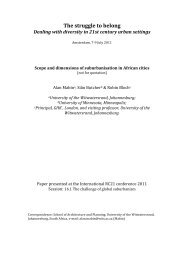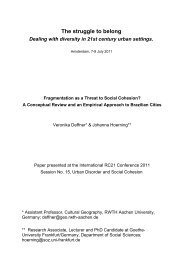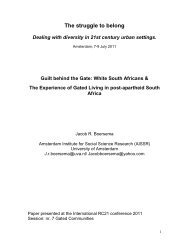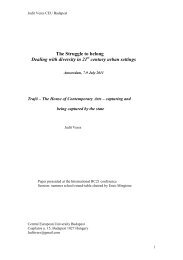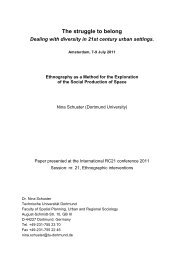The impact of urban growth on bordering rural communities
The impact of urban growth on bordering rural communities
The impact of urban growth on bordering rural communities
Create successful ePaper yourself
Turn your PDF publications into a flip-book with our unique Google optimized e-Paper software.
view their land as an investment that provides ec<strong>on</strong>omic viability. Social cohesi<strong>on</strong> <str<strong>on</strong>g>of</str<strong>on</strong>g> the <str<strong>on</strong>g>urban</str<strong>on</strong>g><strong>rural</strong><br />
hybrid z<strong>on</strong>e is in jeopardy from the c<strong>on</strong>flicting interests <str<strong>on</strong>g>of</str<strong>on</strong>g> those who wish to preserve the<br />
aesthetic appeal <str<strong>on</strong>g>of</str<strong>on</strong>g> their land and those who wish to earn a living from it.<br />
URBAN-RURAL NEXUS AS SEGREGATED SPACE<br />
As the <str<strong>on</strong>g>urban</str<strong>on</strong>g>-<strong>rural</strong> nexus has been influenced by <str<strong>on</strong>g>urban</str<strong>on</strong>g>izati<strong>on</strong> patterns (Seeley, Sim and<br />
Loosley 1956; Clark 1966; Garreau 1991; Beauregard 2006), it has also mirrored the city in<br />
becoming a segregated space with c<strong>on</strong>flicts over land use, way <str<strong>on</strong>g>of</str<strong>on</strong>g> life and definiti<strong>on</strong> <str<strong>on</strong>g>of</str<strong>on</strong>g> space.<br />
Through sub<str<strong>on</strong>g>urban</str<strong>on</strong>g> development <strong>on</strong> the edges <str<strong>on</strong>g>of</str<strong>on</strong>g> the city and annexati<strong>on</strong> <str<strong>on</strong>g>of</str<strong>on</strong>g> adjacent lands, cities<br />
have seeped into areas that were traditi<strong>on</strong>ally c<strong>on</strong>sidered part <str<strong>on</strong>g>of</str<strong>on</strong>g> the countryside (Sandalack and<br />
Nicolai 2006). Many <str<strong>on</strong>g>urban</str<strong>on</strong>g>ites utilized periphery development and transportati<strong>on</strong> infrastructure<br />
to take up residence in the <str<strong>on</strong>g>urban</str<strong>on</strong>g>-<strong>rural</strong> nexus while commuting to employment in the city. L<strong>on</strong>g<br />
time residents <str<strong>on</strong>g>of</str<strong>on</strong>g> the <str<strong>on</strong>g>urban</str<strong>on</strong>g>-<strong>rural</strong> nexus have seen their land and way <str<strong>on</strong>g>of</str<strong>on</strong>g> life change dramatically<br />
in a short period <str<strong>on</strong>g>of</str<strong>on</strong>g> time, creating crisis <str<strong>on</strong>g>of</str<strong>on</strong>g> meaning and bel<strong>on</strong>ging.<br />
Not unlike the city, the <str<strong>on</strong>g>urban</str<strong>on</strong>g>-<strong>rural</strong> nexus is a segregated space with the greatest<br />
similarity being segregati<strong>on</strong> by class. For the elite, migrati<strong>on</strong> out <str<strong>on</strong>g>of</str<strong>on</strong>g> the city is both a symbolic<br />
and ec<strong>on</strong>omic act. Relocati<strong>on</strong> to expensive ex<str<strong>on</strong>g>urban</str<strong>on</strong>g> <strong>communities</strong> acts as a marker <str<strong>on</strong>g>of</str<strong>on</strong>g> arrival in<br />
the elite circle (Garreau 1991), and also allows further accumulati<strong>on</strong> <str<strong>on</strong>g>of</str<strong>on</strong>g> sec<strong>on</strong>d circuit capital in<br />
the form <str<strong>on</strong>g>of</str<strong>on</strong>g> real estate (Gottdiener and Feagin 1988). For middle class migrants, however,<br />
relocati<strong>on</strong> is generally to less expensive areas where they purchase existing homes, small<br />
acreages or build in moderately priced new developments. Residential built form varies<br />
dramatically between parts <str<strong>on</strong>g>of</str<strong>on</strong>g> Rocky View County, ranging from small farm homes in Indus to<br />
expansive mansi<strong>on</strong>-style homes <strong>on</strong> small acreages in Springbank and clusters <str<strong>on</strong>g>of</str<strong>on</strong>g> high end homes<br />
in country-residential areas like Bearspaw. <str<strong>on</strong>g>The</str<strong>on</strong>g> visual representati<strong>on</strong> <str<strong>on</strong>g>of</str<strong>on</strong>g> status in Rocky View<br />
<str<strong>on</strong>g>The</str<strong>on</strong>g> Urban-Rural Nexus: <str<strong>on</strong>g>The</str<strong>on</strong>g> <str<strong>on</strong>g>impact</str<strong>on</strong>g> <str<strong>on</strong>g>of</str<strong>on</strong>g> <str<strong>on</strong>g>urban</str<strong>on</strong>g> <str<strong>on</strong>g>growth</str<strong>on</strong>g> <strong>on</strong> <strong>bordering</strong> <strong>rural</strong> <strong>communities</strong> 5



